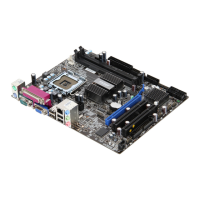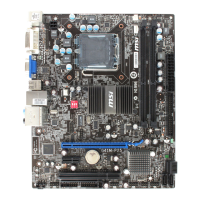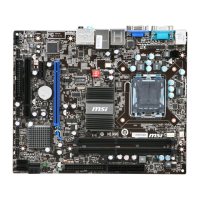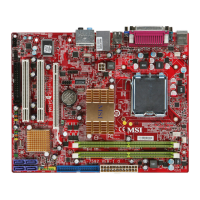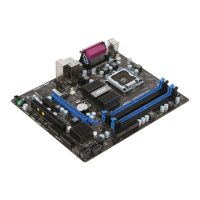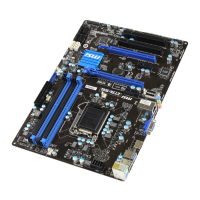Do you have a question about the MSI G41TM-S01 Series and is the answer not in the manual?
Describes the copyright and intellectual property of the document's material.
Lists registered trademarks belonging to their respective owners.
Details the revision history and release dates of the product.
Provides contact information and online resources for technical assistance.
Lists essential safety guidelines for the proper and safe operation of the equipment.
Highlights specific dangers such as electrical shock and battery replacement.
Provides steps to correct potential radio frequency interference in a residential installation.
States notices regarding modifications and the use of shielded cables for compliance.
Explains the EU directive for proper disposal of electrical and electronic equipment.
Introduces the G41TM-S01 Series mainboard and its key features.
Details compatible CPU types and the LGA775 package.
Identifies the North and South bridge chipsets used on the mainboard.
Specifies DDR2 DIMM compatibility and maximum memory capacity.
Describes integrated LAN features and audio capabilities.
Lists the number of SATA 3Gb/s ports provided by the Intel ICH7.
Lists back panel and on-board connectors for various peripherals.
Details the types and number of expansion slots available for add-on cards.
Specifies the Micro-ATX dimensions and mounting hole configuration.
Illustrates and labels key components and connectors on the mainboard.
Lists the items typically found in the product package.
Provides general advice for handling and installing computer components safely.
Visually guides the placement of major components on the mainboard.
Emphasizes cooling and thermal paste application for CPU longevity.
Advises on safely replacing the CPU, including power disconnection.
Discusses mainboard support and risks associated with overclocking.
Details socket preparation, lever operation, and pin protection.
Guides on attaching the CPU cooler to the mainboard correctly.
Lists DDR2 memory types, pin counts, and speed compatibility.
Explains population rules for optimizing memory performance with dual channels.
Important notes on module compatibility and correct slot usage.
Step-by-step guide for inserting RAM sticks into DIMM slots.
How to confirm the memory module is correctly locked in place.
Connection for the main ATX power supply unit.
Dedicated power connector for the CPU.
Guidance on minimum wattage for ensuring system stability.
PS/2 connectors for connecting input devices.
VGA and DVI-D ports for display connection.
RJ-45 Ethernet connection and its status LEDs.
Universal Serial Bus ports for connecting various peripherals.
Explains the color-coded audio jacks and their specific uses.
High-speed interface ports for connecting storage devices.
Connections for front panel switches and LEDs.
Connectors for system and CPU fans, including control features.
Detects if the computer chassis has been opened for security.
Connectors for front panel USB devices.
Connection for front panel audio inputs and outputs.
Connects to a Trusted Platform Module for enhanced security.
For digital audio transmission to compatible graphics cards.
Resets BIOS settings to default values by shorting pins.
Slots for high-speed expansion cards (PCIe x1 and x16).
Standard slots supporting various add-on cards.
Illustrates the IRQ assignments for PCI slots.
Indicates the current CPU power phase status.
Instructions on how to access the BIOS configuration utility.
Method to access BIOS during POST by pressing the DEL key.
How to find the BIOS version displayed at boot time.
Lists shortcuts for navigating and changing settings within BIOS.
Explains how to move between BIOS menus and sub-menus.
Accessing help screens within the BIOS utility.
For basic system configurations like date and time.
For AMI-specific enhanced system features.
Settings for configuring integrated hardware components.
System power saving options and configurations.
Displays hardware health information like temperatures and voltages.
CPU power phase control and LED settings.
Password protection for BIOS settings.
Frequency, voltage, and overclocking adjustments.
Allows adjustment of the system date and time.
Displays information on detected SATA devices.
Shows information about connected SATA devices.
Enables or disables LBA mode for SATA devices.
Selects the DMA transfer mode for SATA devices.
Activates Self-Monitoring Analysis & Reporting Technology for hard drives.
Shows CPU, BIOS version, and memory status.
Protects BIOS from corruption during updates.
Controls the display of the company logo during boot.
Speeds up boot time by skipping certain checks.
Sets the initial state of the Num Lock key upon system power-on.
Enables or disables APIC for expanded IRQ resources.
Selects the Multi-Processor Specification version for the OS.
Specifies the default graphics card for display output.
Controls PCI device bus access time for bandwidth optimization.
Includes Execute Bit Support and CPUID MaxVal limit.
Includes HPET, VGA Share Memory, and DVMT settings.
Sets graphics core memory allocation mode.
Specifies memory size allocation for video memory.
Sets the order of boot devices for system startup.
Configures Trusted Platform Module (TPM) support.
Enables or disables the onboard USB controller.
Enables USB device support in older operating systems.
Enables or disables the onboard LAN controller.
Decides whether to invoke the LAN controller's Boot ROM.
Enables or disables the onboard audio controller.
Configures PCI IDE BusMaster and SATA Controller.
Configures RAID mode for onboard SATA devices.
Activates ACPI and sets power saving modes.
Configures front panel power LED and power button behavior.
Sets system behavior after power interruption.
Configures system wake-up events from sleep states.
Enables or disables chassis intrusion warning.
Manages CPU fan speed based on temperature.
Selects fan speed percentage for SYS FAN1.
Displays system voltages, temperatures, and fan speeds.
Guides on how to set, confirm, and clear the BIOS password.
Auto-adjusts CPU power phase for power saving.
Enables or disables onboard LEDs.
Shows current CPU clocks and detailed CPU specifications.
Displays memory SPD (Serial Presence Detect) information.
Lists CPU supported technologies like MMX, SSE, and Hyper-Threading.
Allows setting the CPU Front Side Bus frequency.
Adjusts the CPU multiplier for performance tuning.
Displays the calculated CPU frequency (FSB x Ratio).
Provides advanced memory timing settings.
Controls DRAM timing via SPD or manual configuration.
Detailed memory timing parameters like tRCD, tRP, tRAS.
Adjusts memory ratios and frequencies relative to FSB.
Minimizes EMI by disabling clocks for unused slots.
Adjusts CPU, DRAM, NB, and VTT FSB voltages.
Provides guidelines for safe CPU and DRAM voltage settings.
Reduces EMI by modulating clock pulses.
Explains recovery from failed overclocking via multiple reboots.
Refers to clearing CMOS data for system recovery.
Allows saving current BIOS settings to CMOS.
Allows loading previously saved BIOS configurations.
Describes flashing BIOS from USB drive or booting from it.
Restores stable default settings for system stability.
Restores optimal performance default settings.
Describes the 10-channel DAC and sound capabilities.
Guides on installing the audio driver for Windows XP.
Explains how to access the audio configuration utility via system tray or Control Panel.
Allows selection of sound environments and equalizer settings.
Details equalizer controls for customizing audio output.
Offers pre-optimized equalizer settings for quick enjoyment.
Vocal cancellation and key adjustment for karaoke.
Controls volume levels for playback devices.
Allows simultaneous playback from different sources.
Configures volume controls and enables multi-streaming playback.
Decides which ports output sound for multi-streaming.
Controls muting and display of volume control items.
Selects recording inputs like Mic, Line, or Stereo Mix.
Enables simultaneous recording from multiple channels.
Configures speaker output for stereo, 5.1, or 7.1 systems.
Configures front panel jack detection and rear output muting.
Configures output sampling rate and source for digital audio.
Guides on testing individual speaker functionality.
Controls microphone noise reduction and acoustic echo cancellation.
Allows adjustment of 3D audio and environment selection.
Displays driver version, DirectX, and language settings.
Lists prerequisites for installing the Overclocking Center utility.
Explains how to launch the utility from the desktop shortcut.
Guides on launching the utility from the Start menu.
Shows details of the mainboard, CPU, and graphics card.
Displays CPU state, temperature, voltage, fan speed, and usage.
Allows adjustment of clock speeds, voltages, and fan control.
Guides on selecting values for manual overclocking.
Sets thresholds for CPU temperature and fan speed warnings.
Describes the copyright and intellectual property of the document's material.
Lists registered trademarks belonging to their respective owners.
Details the revision history and release dates of the product.
Provides contact information and online resources for technical assistance.
Lists essential safety guidelines for the proper and safe operation of the equipment.
Highlights specific dangers such as electrical shock and battery replacement.
Provides steps to correct potential radio frequency interference in a residential installation.
States notices regarding modifications and the use of shielded cables for compliance.
Explains the EU directive for proper disposal of electrical and electronic equipment.
Introduces the G41TM-S01 Series mainboard and its key features.
Details compatible CPU types and the LGA775 package.
Identifies the North and South bridge chipsets used on the mainboard.
Specifies DDR2 DIMM compatibility and maximum memory capacity.
Describes integrated LAN features and audio capabilities.
Lists the number of SATA 3Gb/s ports provided by the Intel ICH7.
Lists back panel and on-board connectors for various peripherals.
Details the types and number of expansion slots available for add-on cards.
Specifies the Micro-ATX dimensions and mounting hole configuration.
Illustrates and labels key components and connectors on the mainboard.
Lists the items typically found in the product package.
Provides general advice for handling and installing computer components safely.
Visually guides the placement of major components on the mainboard.
Emphasizes cooling and thermal paste application for CPU longevity.
Advises on safely replacing the CPU, including power disconnection.
Discusses mainboard support and risks associated with overclocking.
Details socket preparation, lever operation, and pin protection.
Guides on attaching the CPU cooler to the mainboard correctly.
Lists DDR2 memory types, pin counts, and speed compatibility.
Explains population rules for optimizing memory performance with dual channels.
Important notes on module compatibility and correct slot usage.
Step-by-step guide for inserting RAM sticks into DIMM slots.
How to confirm the memory module is correctly locked in place.
Connection for the main ATX power supply unit.
Dedicated power connector for the CPU.
Guidance on minimum wattage for ensuring system stability.
PS/2 connectors for connecting input devices.
VGA and DVI-D ports for display connection.
RJ-45 Ethernet connection and its status LEDs.
Universal Serial Bus ports for connecting various peripherals.
Explains the color-coded audio jacks and their specific uses.
High-speed interface ports for connecting storage devices.
Connections for front panel switches and LEDs.
Connectors for system and CPU fans, including control features.
Detects if the computer chassis has been opened for security.
Connectors for front panel USB devices.
Connection for front panel audio inputs and outputs.
Connects to a Trusted Platform Module for enhanced security.
For digital audio transmission to compatible graphics cards.
Resets BIOS settings to default values by shorting pins.
Slots for high-speed expansion cards (PCIe x1 and x16).
Standard slots supporting various add-on cards.
Illustrates the IRQ assignments for PCI slots.
Indicates the current CPU power phase status.
Instructions on how to access the BIOS configuration utility.
Method to access BIOS during POST by pressing the DEL key.
How to find the BIOS version displayed at boot time.
Lists shortcuts for navigating and changing settings within BIOS.
Explains how to move between BIOS menus and sub-menus.
Accessing help screens within the BIOS utility.
For basic system configurations like date and time.
For AMI-specific enhanced system features.
Settings for configuring integrated hardware components.
System power saving options and configurations.
Displays hardware health information like temperatures and voltages.
CPU power phase control and LED settings.
Password protection for BIOS settings.
Frequency, voltage, and overclocking adjustments.
Allows adjustment of the system date and time.
Displays information on detected SATA devices.
Shows information about connected SATA devices.
Enables or disables LBA mode for SATA devices.
Selects the DMA transfer mode for SATA devices.
Activates Self-Monitoring Analysis & Reporting Technology for hard drives.
Shows CPU, BIOS version, and memory status.
Protects BIOS from corruption during updates.
Controls the display of the company logo during boot.
Speeds up boot time by skipping certain checks.
Sets the initial state of the Num Lock key upon system power-on.
Enables or disables APIC for expanded IRQ resources.
Selects the Multi-Processor Specification version for the OS.
Specifies the default graphics card for display output.
Controls PCI device bus access time for bandwidth optimization.
Includes Execute Bit Support and CPUID MaxVal limit.
Includes HPET, VGA Share Memory, and DVMT settings.
Sets graphics core memory allocation mode.
Specifies memory size allocation for video memory.
Sets the order of boot devices for system startup.
Configures Trusted Platform Module (TPM) support.
Enables or disables the onboard USB controller.
Enables USB device support in older operating systems.
Enables or disables the onboard LAN controller.
Decides whether to invoke the LAN controller's Boot ROM.
Enables or disables the onboard audio controller.
Configures PCI IDE BusMaster and SATA Controller.
Configures RAID mode for onboard SATA devices.
Activates ACPI and sets power saving modes.
Configures front panel power LED and power button behavior.
Sets system behavior after power interruption.
Configures system wake-up events from sleep states.
Enables or disables chassis intrusion warning.
Manages CPU fan speed based on temperature.
Selects fan speed percentage for SYS FAN1.
Displays system voltages, temperatures, and fan speeds.
Guides on how to set, confirm, and clear the BIOS password.
Auto-adjusts CPU power phase for power saving.
Enables or disables onboard LEDs.
Shows current CPU clocks and detailed CPU specifications.
Displays memory SPD (Serial Presence Detect) information.
Lists CPU supported technologies like MMX, SSE, and Hyper-Threading.
Allows setting the CPU Front Side Bus frequency.
Adjusts the CPU multiplier for performance tuning.
Displays the calculated CPU frequency (FSB x Ratio).
Provides advanced memory timing settings.
Controls DRAM timing via SPD or manual configuration.
Detailed memory timing parameters like tRCD, tRP, tRAS.
Adjusts memory ratios and frequencies relative to FSB.
Minimizes EMI by disabling clocks for unused slots.
Adjusts CPU, DRAM, NB, and VTT FSB voltages.
Provides guidelines for safe CPU and DRAM voltage settings.
Reduces EMI by modulating clock pulses.
Explains recovery from failed overclocking via multiple reboots.
Refers to clearing CMOS data for system recovery.
Allows saving current BIOS settings to CMOS.
Allows loading previously saved BIOS configurations.
Describes flashing BIOS from USB drive or booting from it.
Restores stable default settings for system stability.
Restores optimal performance default settings.
Describes the 10-channel DAC and sound capabilities.
Guides on installing the audio driver for Windows XP.
Explains how to access the audio configuration utility via system tray or Control Panel.
Allows selection of sound environments and equalizer settings.
Details equalizer controls for customizing audio output.
Offers pre-optimized equalizer settings for quick enjoyment.
Vocal cancellation and key adjustment for karaoke.
Controls volume levels for playback devices.
Allows simultaneous playback from different sources.
Configures volume controls and enables multi-streaming playback.
Decides which ports output sound for multi-streaming.
Controls muting and display of volume control items.
Selects recording inputs like Mic, Line, or Stereo Mix.
Enables simultaneous recording from multiple channels.
Configures speaker output for stereo, 5.1, or 7.1 systems.
Configures front panel jack detection and rear output muting.
Configures output sampling rate and source for digital audio.
Guides on testing individual speaker functionality.
Controls microphone noise reduction and acoustic echo cancellation.
Allows adjustment of 3D audio and environment selection.
Displays driver version, DirectX, and language settings.
Lists prerequisites for installing the Overclocking Center utility.
Explains how to launch the utility from the desktop shortcut.
Guides on launching the utility from the Start menu.
Shows details of the mainboard, CPU, and graphics card.
Displays CPU state, temperature, voltage, fan speed, and usage.
Allows adjustment of clock speeds, voltages, and fan control.
Guides on selecting values for manual overclocking.
Sets thresholds for CPU temperature and fan speed warnings.
| Brand | MSI |
|---|---|
| Model | G41TM-S01 Series |
| Category | Motherboard |
| Language | English |

